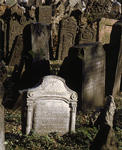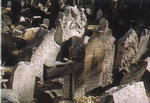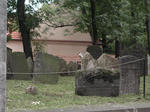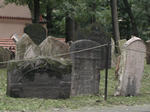The Old Jewish Cemetery in Josefov, the Jewish Quarter, is
the oldest cemetery in Europe. It was created in the 15
th century when Jews were forbidden to bury their dead outside their own district and funerals were banned in the center of town. Space was scarce, so bodies were buried on top of each other in an estimated 12 layers. This was the only cemetery for Jews until 1787. Nobody knows exactly how many people lie buried here but the history books say 20.000 people in 12 layers, as a grave is permanent once

it has been established according to Jewish beliefs.
The most well-known person buried here is
Rabbi Judah Low ben Bezalel, who died in the year 1609. Rabbi Low worked for 36 years as a headmaster of
the Talmudic school and later as a master Rabbi. He published more than 50 religious and philosophical books.
Open from April to October: 9 am - 6 pm, from November to March: 9 am - 4.30 pm (Saturday it is closed)
Trams 17,18 or Metro line 'A' - station 'Staromestska'
Surrealist author Franz Kafka enjoyed moments of quiet reflection in the old cemetery. However, his own grave lies across town in the New Jewish Cemetery. That burial ground is half empty because the generation it was built for was transported to Nazi death camps.
 New Jewish Cemetery
New Jewish Cemetery
Prague 3, Zizkov, Nad Vodojemem
Access: Metro "A", Zelivskeho station; tram Nos. 11, 16, 19, 26, Zelivskeho stop
The New Jewish Cemetery has been in use since the end of the 19th century, when the neo-Renaissance hall of ceremonies and the cemetery wall were also erected. The later Functionalist hall is a part of the urn cemetery founded in 1933.
Many Jewish personalities who were a part of Prague's cultural life have been buried here. The best-known among them are certainly author Franz Kafka, one of Prague's German-speaking community, Czech Existentialist poet Jiri Orten, and the author of sports journalists Ota Pavel. Max Brod, Kafka's friend and publisher who died in Tel Aviv, has a memorial plaque at the cemetary. The cemetery is in fact a large collection of modern funeral architecture and sculpture.



 Guide
Guide 





